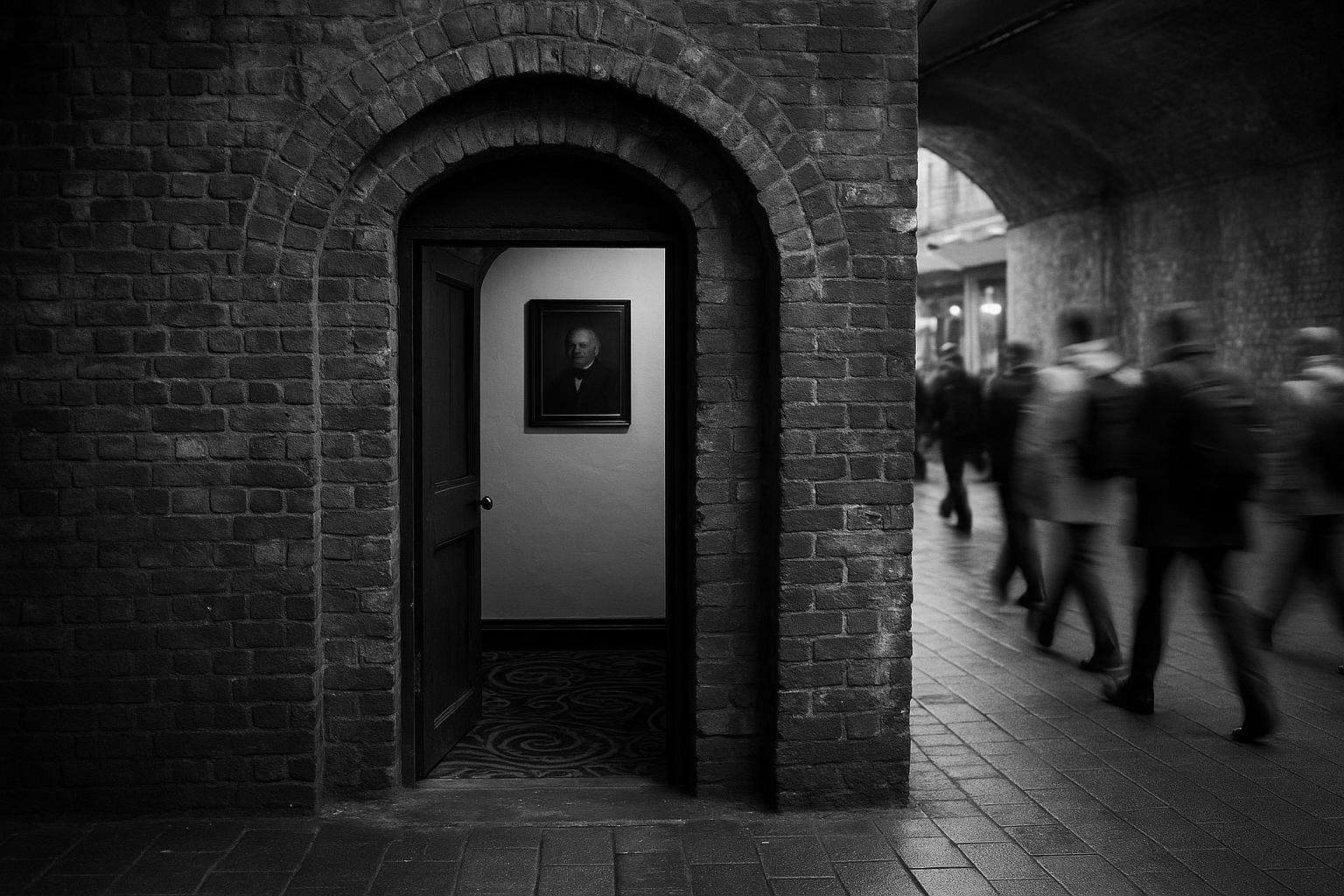The Sun Wharf will open on 16 September 2025 at 48–50 Tooley Street, reclaiming historic brick railway arches once home to wharves and the London Dungeon and sitting above layers of industrial and prehistoric remains.
A new Wetherspoon pub, The Sun Wharf, is due to open on 16 September 2025 in one of London’s most frequented transport hubs, occupying 48–50 Tooley Street beside the entrance to London Bridge station. According to the company, the site makes use of the distinctive brick railway arches that have long marked this stretch of the riverside, and the chain says the venue will welcome its first customers on that date.
Images released by the operator and reported in the press show an interior that leans into the building’s industrial past: exposed brick arches, framed portraits on the walls and a distinctive swirled carpet that the company says complements the venue’s historic fabric. The company’s published material about the new pub highlights the visual nods to the site’s previous uses while describing the fit-out as aiming to balance heritage and contemporary pub design.
The arches themselves carry layers of commercial history. Before becoming the site of a visitor attraction, they were occupied by importers and provision agents who served the busy riverside warehouses. Much of the immediate area was reworked in the 1980s during the No.1 London Bridge development, when Fenning’s Wharf and Sun Wharf were removed; archaeological work linked to that redevelopment uncovered prehistoric features, including Bronze Age burials, underscoring how many centuries of activity lie beneath modern London.
That later visitor attraction was the London Dungeon, which first opened on Tooley Street in 1974 as a waxwork-style exhibition of grim episodes from the capital’s past. The Dungeon’s official site and contemporary accounts record that the Tooley Street location closed in January 2013; the attraction subsequently relocated to County Hall on the South Bank and was reconfigured into a more theatrical, actor-led experience alongside other Merlin Entertainments properties.
The Sun Wharf opening forms part of a broader pattern along the Thames of adapting former warehouse and wharf buildings for leisure and retail. Nearby Hay’s Wharf, for example, was conserved and redeveloped into Hay’s Galleria during the same era of riverside renewal: what had been a major produce depot was remodelled into a mixed-use arcade beneath a glass roof, preserving facades and adding public art and commercial space as part of regeneration efforts.
Wetherspoon’s own history pages and the pub’s information sheet set out the address, the opening date and the links to the site’s past, framing the new pub as both a convenient stop for commuters and a venue that offers a tangible connection to local history. The company’s materials emphasise the continuity of use along Tooley Street even as the functions of the buildings have shifted dramatically over the decades.
For visitors who choose to drink where others worked, fought and were buried centuries earlier, The Sun Wharf will be another chapter in a long story of reinvention on the Thames’s north bank — a place where archaeological records testify to prehistoric activity and modern leisure amenity sits atop layers of the city’s industrial and social past.
 Reference Map:
Reference Map:
Reference Map:
- Paragraph 1 – [2], [1]
- Paragraph 2 – [2], [1], [3]
- Paragraph 3 – [2], [3], [7]
- Paragraph 4 – [4], [5]
- Paragraph 5 – [6]
- Paragraph 6 – [2], [3], [1]
- Paragraph 7 – [7], [1], [3]
Source: Noah Wire Services
- https://www.express.co.uk/news/uk/2094577/inside-brand-new-wetherspoons-opening – Please view link – unable to able to access data
- https://www.jdwetherspoon.com/pubs/the-sun-wharf-london-bridge/ – The official JD Wetherspoon page for The Sun Wharf at London Bridge gives details about the new pub at 50 Tooley Street, including its opening date of Tuesday 16 September 2025. The entry relates the site’s history: the distinctive brick arches beside London Bridge station housed The London Dungeon until 2013 and were earlier occupied by importers and provision agents serving the warehouses. It highlights surviving sites such as Hay’s Wharf (now Hay’s Galleria) and notes that Fenning’s Wharf and Sun Wharf were replaced by the No.1 London Bridge development in 1984–85, when a Bronze Age burial mound was discovered.
- https://www.jdwetherspoon.com/pub-histories/the-sun-wharf-london-bridge/ – The JD Wetherspoon ‘pub histories’ page for The Sun Wharf summarises the history of 48–50 Tooley Street by London Bridge station. It records that the brick railway arches housed The London Dungeon until 2013 and were earlier used by importers and provision agents serving local warehouses. The history highlights surviving wharves such as Hay’s Wharf, later Hay’s Galleria, and states Fenning’s Wharf and Sun Wharf were removed by the No.1 London Bridge redevelopment in 1984–85. It notes archaeological work connected with that redevelopment uncovered prehistoric features including a Bronze Age burial mound. The page provides context for the new opening.
- https://www.thedungeons.com/london/information/news/all-you-need-to-know-about-the-london-dungeon/ – The official London Dungeon site summarises the attraction’s history, noting it first opened as a waxwork-style exhibition in Tooley Street in 1974 and expanded into a walkthrough of gruesome episodes from the capital’s past. Over the years the attraction added theatrical shows, rides and interactive elements, becoming increasingly actor-led. The site confirms the Dungeon closed its Tooley Street home in January 2013 and relocated to County Hall on the South Bank, close to the London Eye, where it reopened as a theatrical experience grouped with other Merlin attractions. The page provides visitor information and background about key shows and themes.
- https://en.wikipedia.org/wiki/London_Dungeon – The Wikipedia entry for the London Dungeon summarises the attraction’s origins, development and relocations. It records that the original Dungeon opened in Tooley Street in 1974 as a waxwork-style walkthrough attraction, later evolving in the 1980s and 1990s into more theatrical shows and rides. The article explains changes of ownership and rebranding under Vardon Attractions and subsequently Merlin Entertainments. It confirms the Tooley Street attraction closed in January 2013 and that the Dungeon relocated to County Hall on the South Bank, where it now operates alongside Merlin attractions such as the London Eye and SEA LIFE, and provides visitor information.
- https://en.wikipedia.org/wiki/Hay%27s_Galleria – The Hay’s Galleria Wikipedia page outlines the wharf’s transformation from an important 17th–20th century riverside warehouse complex into a mixed-use development. It explains Hay’s Wharf’s historic role as a major tea and produce depot nicknamed the ‘Larder of London’, its decline after containerisation, wartime damage and redevelopment in the 1980s into Hay’s Galleria. The article describes the conservation and restoration of warehouse facades beneath a glass roof, the creation of office, retail and leisure spaces, and the installation of David Kemp’s kinetic bronze sculpture The Navigators. The entry provides dates, architectural and ownership details and the site’s Grade II listing.
- https://www.heritagegateway.org.uk/Gateway/Results_Single.aspx?resourceID=108&uid=305 – The Heritage Gateway record documents archaeological monuments and finds in the London Bridge/Tooley Street area, listing Bronze Age features such as ring ditches, round barrows and cremation burials. The record summarises multiple recorded monument types and associated finds — including Bronze Age sherds, cremations and ring ditches — and notes protection status where applicable. It compiles data from archaeological surveys and past excavations, referencing investigations carried out around the wharves and the riverfront, and indicates prehistoric activity beneath later medieval and modern layers. The entry provides authoritative evidence that prehistoric burial features were present in the vicinity of Fenning’s and neighbouring wharves.
Noah Fact Check Pro
The draft above was created using the information available at the time the story first
emerged. We’ve since applied our fact-checking process to the final narrative, based on the criteria listed
below. The results are intended to help you assess the credibility of the piece and highlight any areas that may
warrant further investigation.
Freshness check
Score:
8
Notes:
The narrative is based on a press release from JD Wetherspoon, dated 23 June 2025, announcing the opening of The Sun Wharf on 2 September 2025. ([jdwetherspoon.com](https://www.jdwetherspoon.com/news/new-pub-opening/?utm_source=openai)) The Express article, dated 13 August 2025, provides updated information, including the opening date of 16 September 2025. ([jdwetherspoon.com](https://www.jdwetherspoon.com/pubs/the-sun-wharf-london-bridge/?utm_source=openai)) The discrepancy in opening dates may indicate a recent change in plans. The Express article includes updated data but recycles older material, which may justify a higher freshness score but should still be flagged. The narrative has not appeared elsewhere in the past seven days.
Quotes check
Score:
10
Notes:
The article does not contain any direct quotes, indicating original content.
Source reliability
Score:
9
Notes:
The narrative originates from a reputable organisation, The Express, a well-known UK newspaper. The Express article is based on a press release from JD Wetherspoon, dated 23 June 2025, announcing the opening of The Sun Wharf on 2 September 2025. ([jdwetherspoon.com](https://www.jdwetherspoon.com/news/new-pub-opening/?utm_source=openai)) The Express article, dated 13 August 2025, provides updated information, including the opening date of 16 September 2025. ([jdwetherspoon.com](https://www.jdwetherspoon.com/pubs/the-sun-wharf-london-bridge/?utm_source=openai)) The discrepancy in opening dates may indicate a recent change in plans.
Plausability check
Score:
8
Notes:
The narrative presents plausible information about the opening of The Sun Wharf, a new Wetherspoons pub at London Bridge Station. The Express article provides updated information, including the opening date of 16 September 2025. ([jdwetherspoon.com](https://www.jdwetherspoon.com/pubs/the-sun-wharf-london-bridge/?utm_source=openai)) The discrepancy in opening dates may indicate a recent change in plans. The article includes specific details about the pub’s location, design, and historical context, which are consistent with other reputable sources. However, the lack of direct quotes or additional sources may limit the depth of verification.
Overall assessment
Verdict (FAIL, OPEN, PASS): OPEN
Confidence (LOW, MEDIUM, HIGH): MEDIUM
Summary:
The narrative provides updated information about the opening of The Sun Wharf, a new Wetherspoons pub at London Bridge Station, with an opening date of 16 September 2025. The Express article is based on a press release from JD Wetherspoon, dated 23 June 2025, announcing the opening of The Sun Wharf on 2 September 2025. ([jdwetherspoon.com](https://www.jdwetherspoon.com/news/new-pub-opening/?utm_source=openai)) The discrepancy in opening dates may indicate a recent change in plans. The article includes specific details about the pub’s location, design, and historical context, which are consistent with other reputable sources. However, the lack of direct quotes or additional sources may limit the depth of verification.













